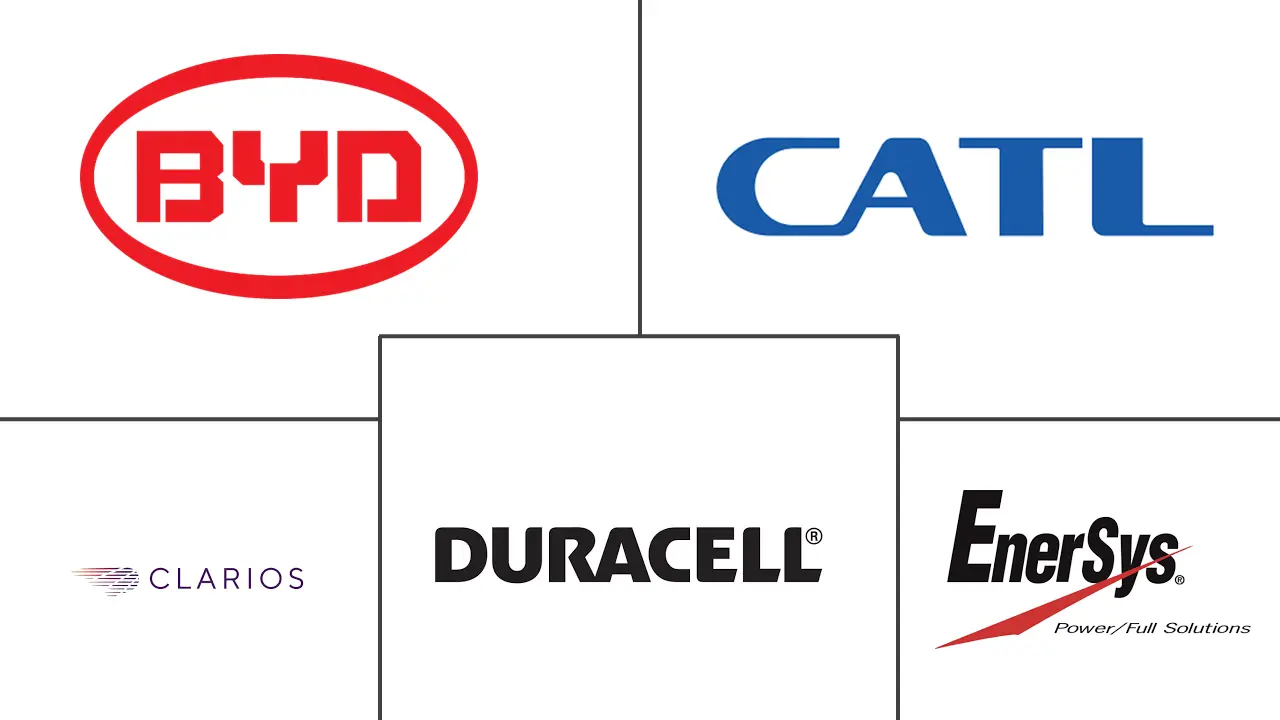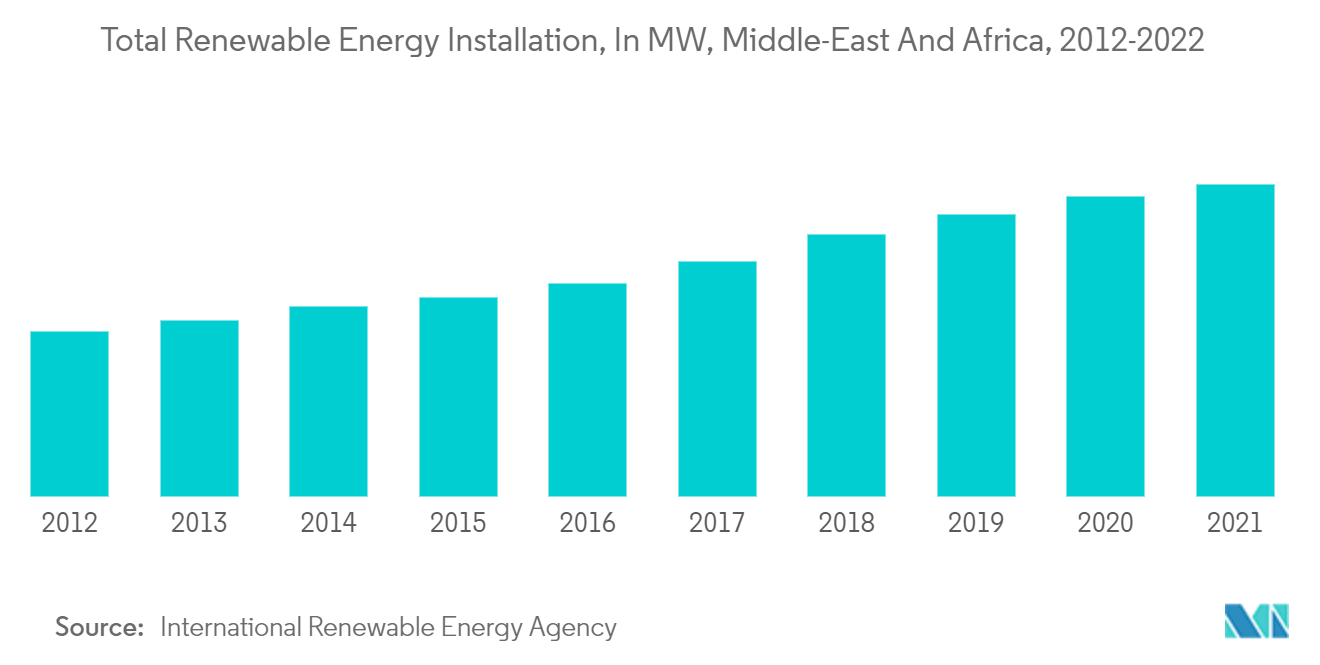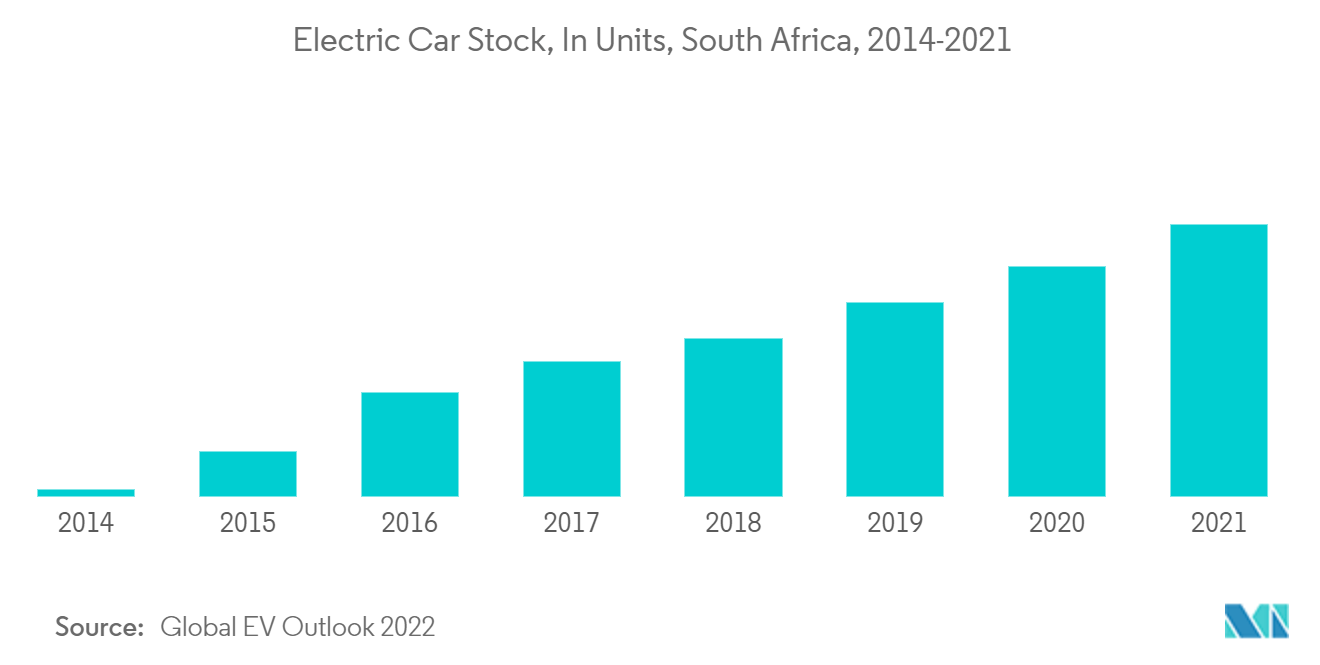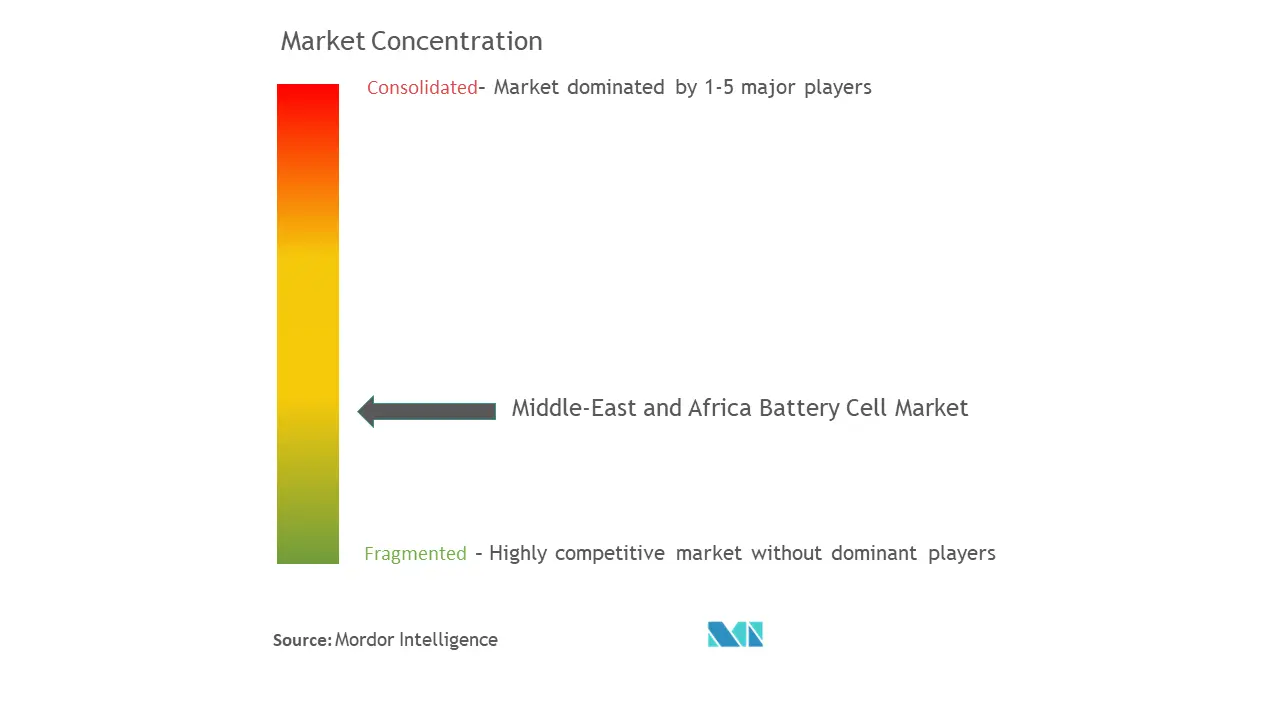MEA Battery Cell Market Size

| Study Period | 2020 - 2029 |
| Base Year For Estimation | 2023 |
| Forecast Data Period | 2024 - 2029 |
| Historical Data Period | 2020 - 2022 |
| CAGR | 13.20 % |
| Market Concentration | Medium |
Major Players
*Disclaimer: Major Players sorted in no particular order |
MEA Battery Cell Market Analysis
The Middle-East and Africa battery cell market is expected to register a CAGR of more than 13.2% during the forecast period. Covid-19 was first detected in China between late 2019 and early 2020; since then, countries across the globe have been under strict lockdown, drastically impacting the battery cell market. In the Middle East and Africa, the battery market is import based, and due to restrictions on cross-border trades, the industry was negative impacts. Factors such as the significant rise in investment and development of renewable energy projects and supportive government policies and schemes to promote renewable energy coupled with rising EV sales are expected drivers for the Middle East and Africa battery cell market in the forecast period. However, battery cell safety concerns and a rise in battery caching fire incidents are expected to hinder the battery cell market in the near future.
- Rising investment in renewable energy projects and supportive government policies are likely to drive the battery cell market during the forecast period.
- Increased focus on the safety of battery cells coupled with rising investment in R&D of battery cells is expected to present a significant opportunity for battery cell manufacturing companies in the near future.
- South Africa has dominated the battery cell market. The government's supportive policies for the development of renewable energy sources, as well as EVs-related infrastructure development, are expected to drive the market in the country.
MEA Battery Cell Market Trends
This section covers the major market trends shaping the MEA Battery Cell Market according to our research experts:
Rising renewable Energy Generation
- Over the last decade, the renewable energy installed capacity and generation have been rising steadily in the Middle East and Africa. As renewable resources such as solar and wind generate power intermittently and at various levels, storing this energy later during peak demand is vital. Due to this, modern energy-storing systems are becoming an indispensable part of renewable energy projects.
- Traditionally, pumped storage systems are the most widely-used energy storage technology utilized globally. However, due to the geographical limitations of pumped hydro storage, large land footprint, and declining battery costs, battery energy storage systems have become increasingly popular for energy storage generated from renewable energy sources.
- Various governments across the Middle East and Africa are heavily investing in renewable energy projects to achieve net-zero emissions by 2050. For instance, according to the International Renewable Energy Agency (IRENA), United Arab Emirates is expected to install more than 18 GW of solar energy by 2030, which, in turn, is expected to drive the demand for smart grid networks as it is essential to integrate the renewable power sources, thus, creating vast opportunities for battery cell market players in the future.
- The Saudi Arabian government is significantly investing in renewable energy projects, and the government aims to generate 50% of its energy from renewable sources by 2030. Furthermore, Under Vision 2030, the country is projected to produce 27.3 GW of renewable energy by 2024 and 58.7 GW by 2030. To achieve these renewable energy targets government is working on around 13 renewable energy projects in the country. The projects have a total capacity of 4,870 MW, a solar PV capacity of 4,470 MW and wind at 400 MW. These projects are expected to be commercial by 2024. Thus, such government initiatives are likely to drive the demand for cylindrical and prismatic battery cells during the forecast period.
- Egypt is considered the most favourable African country for renewable energy project development and investment due to ideal conditions for solar energy projects in the country. In 2021, Egypt received a significant amount of foreign direct investments. Egypt's new renewable energy projects rose to USD 3.5 billion in 2021, double the registered value in 2020, with an electricity production capacity of about 3,570 MW. Furthermore, in December 2021, United Arab Emirates-based company Alnowais investment is to invest USD 1 billion in two clean energy projects in Egypt. The projects are expected to be in operation by 2025.
- All these initiatives taken by the governments in the Middle East and Africa are expected to witness a significant rise in demand for energy-storing systems, propelling the battery cell market during the forecast period.

South Africa Dominate the market
- According to the University of Oxford's Environment Change Institute study, in January 2022, South Africa has been identified as the most favourable African country for renewable energy project development and investments. The study states that strategic investments in solar and wind are crucial to ensuring energy security and sustainability across Africa.
- Due to this favourable condition for solar and wind energy projects, many countries are investing in renewable energy projects. For instance, in November 2021, the United States, United Kingdom, France, Germany, and the European Union agreed on a multi-billion-dollar partnership to help South Africa finance a quicker transition from coal to renewable energy. The initiative was valued at USD 8.5 billion.
- Furthermore, on 23rd March 2022, Norway and United Kingdom are also investing USD 39 Million in South Africa's Renewable Energy. This investment would help company H1 Capital build 2,400 MW of new wind and solar plants.
- The government of South Africa approved the Integrated Resource Plan (IRP) 2019, which aims to increase the renewable energy share in the total energy mix. By 2030, the country aims for an additional capacity of 14.4 GW of wind power, 6 GW of solar, 3 GW of gas, 2.5 GW of hydropower, 2.088 GW of storage, including battery energy storage systems, and 1.5 GW of coal.
- In June 2021, Eskom, South Africa's leading utility company and biggest greenhouse gas emitter, is planning to invest USD 10 billion in renewable energy projects and is expected to close its majority of coal-fired power stations by 2050. The company generates more than 90% of South Africa's electricity and aims to invest more in solar energy projects to achieve countries' net-zero emissions by 2050.
- The South African government is promoting electric vehicles. EV sales in 2021 were 1,739, which is more than 18% compared to the 2020 EV sales. The rise in auto sales can be ascribed to the South African government's support, such as incentive schemes and subsidies to manufacturers and buyers, which aims to boost exports of vehicles and components with a new focus on electric vehicles.
- Thus, these initiatives from the government are likely to witness an increase in investment in EVs and renewable energy, which would likely drive the battery cell market in South Africa during the forecast period.

MEA Battery Cell Industry Overview
The Middle-East and Africa battery cell market is highly fragmented. Some of the key players in the market include BYD Co. Ltd, Contemporary Amperex Technology Co. Limited, Duracell Inc., EnerSys, and Clarios.
MEA Battery Cell Market Leaders
-
BYD Co. Ltd
-
Contemporary Amperex Technology Co. Limited
-
Duracell Inc.
-
EnerSys
-
Clarios
*Disclaimer: Major Players sorted in no particular order

MEA Battery Cell Market News
- In February 2022, EV Metals group signed a Front-End Engineering Design Agreement with Mustang and Faisal Jameel Al Hejailan Consulting Engineering Company, a Wood Plc subsidiary, to develop a lithium chemicals plant in Saudi Arabia. The company is developing the world's first integrated Battery Chemicals Complex at Yanbu Industrial City in Saudi Arabia. The complex will produce high purity chemicals such as lithium, nickel, cobalt, manganese, and other metals and active cathode materials for electric vehicles and renewable energy storage.
- Panasonic Corporation has commenced the production of its latest 4680-type cylindrical battery cells in Japan. The company has supplied samples of its new 4680-cylindrical cells to Electrical Vehicle maker Tesla Inc. as a part of bulk order received recently for cylindrical cells.
MEA Battery Cell Market Report - Table of Contents
1. INTRODUCTION
- 1.1 Scope of Study
- 1.2 Market Definition
- 1.3 Study Assumptions
2. RESEARCH METHODOLOGY
3. EXECUTIVE SUMMARY
4. MARKET OVERVIEW
- 4.1 Introduction
- 4.2 Market Size and Demand Forecast in USD million, till 2027
- 4.3 Recent Trends and Developments
- 4.4 Government Policies and Regulations
-
4.5 Market Dynamics
- 4.5.1 Drivers
- 4.5.2 Restraints
- 4.6 Supply Chain Analysis
-
4.7 Porter's Five Forces Analysis
- 4.7.1 Bargaining Power of Suppliers
- 4.7.2 Bargaining Power of Consumers
- 4.7.3 Threat of New Entrants
- 4.7.4 Threat of Substitute Products and Services
- 4.7.5 Intensity of Competitive Rivalry
5. MARKET SEGMENTATION
-
5.1 Type
- 5.1.1 Prismatic
- 5.1.2 Cylindrical
- 5.1.3 Pouch
-
5.2 Application
- 5.2.1 Automotive Batteries (HEV, PHEV, EV)
- 5.2.2 Industrial Batteries (Motive, Stationary (Telecom, UPS, Energy Storage Systems (ESS), etc.)
- 5.2.3 Portable Batteries (Consumer Electronics etc.)
- 5.2.4 Power Tools Batteries
- 5.2.5 SLI Batteries
- 5.2.6 Others
-
5.3 Geography
- 5.3.1 United Arab Emirates
- 5.3.2 Saudi Arabian
- 5.3.3 South Africa
- 5.3.4 Res of Middle-East and Africa
6. COMPETITIVE LANDSCAPE
- 6.1 Mergers & Acquisitions, Joint Ventures, Collaborations, and Agreements
- 6.2 Strategies Adopted by Leading Players
-
6.3 Company Profiles
- 6.3.1 BYD Co. Ltd
- 6.3.2 Contemporary Amperex Technology Co. Limited
- 6.3.3 Duracell Inc.
- 6.3.4 EnerSys
- 6.3.5 Clarios
- 6.3.6 LG Chem Ltd (changed to LG Energy Solution, Ltd.)
- 6.3.7 Panasonic Corporation
- 6.3.8 Saft Groupe S.A.
- 6.3.9 ElringKlinger AG
- 6.3.10 GS Yuasa Corporation
- *List Not Exhaustive
7. MARKET OPPORTUNITIES AND FUTURE TRENDS
** Subject To AvailablityMEA Battery Cell Industry Segmentation
The Scope of the Middle-East and Africa battery cell market includes:-
| Type | Prismatic |
| Cylindrical | |
| Pouch | |
| Application | Automotive Batteries (HEV, PHEV, EV) |
| Industrial Batteries (Motive, Stationary (Telecom, UPS, Energy Storage Systems (ESS), etc.) | |
| Portable Batteries (Consumer Electronics etc.) | |
| Power Tools Batteries | |
| SLI Batteries | |
| Others | |
| Geography | United Arab Emirates |
| Saudi Arabian | |
| South Africa | |
| Res of Middle-East and Africa |
MEA Battery Cell Market Research FAQs
What is the current Middle-East and Africa Battery Cell Market size?
The Middle-East and Africa Battery Cell Market is projected to register a CAGR of greater than 13.20% during the forecast period (2024-2029)
Who are the key players in Middle-East and Africa Battery Cell Market?
BYD Co. Ltd, Contemporary Amperex Technology Co. Limited, Duracell Inc., EnerSys and Clarios are the major companies operating in the Middle-East and Africa Battery Cell Market.
What years does this Middle-East and Africa Battery Cell Market cover?
The report covers the Middle-East and Africa Battery Cell Market historical market size for years: 2020, 2021, 2022 and 2023. The report also forecasts the Middle-East and Africa Battery Cell Market size for years: 2024, 2025, 2026, 2027, 2028 and 2029.
Middle-East and Africa Battery Cell Industry Report
Statistics for the 2024 Middle-East and Africa Battery Cell market share, size and revenue growth rate, created by Mordor Intelligence™ Industry Reports. Middle-East and Africa Battery Cell analysis includes a market forecast outlook to 2029 and historical overview. Get a sample of this industry analysis as a free report PDF download.



